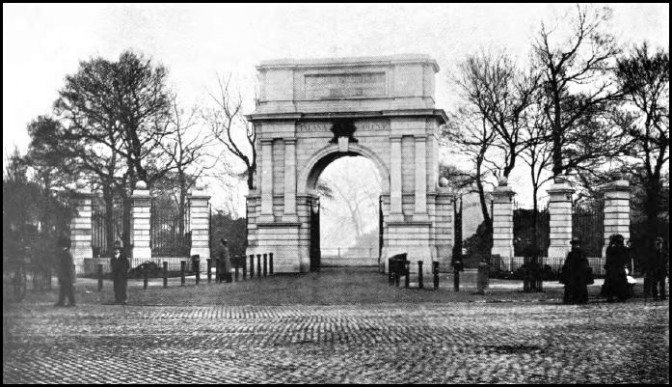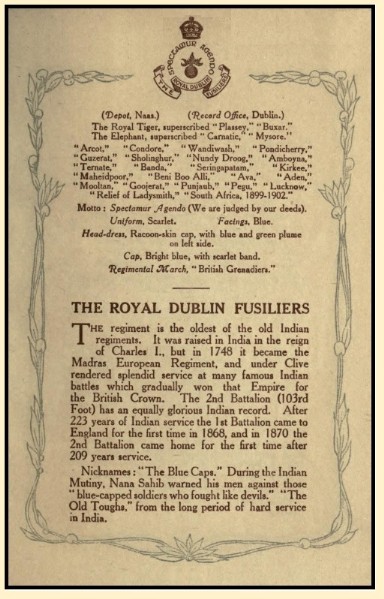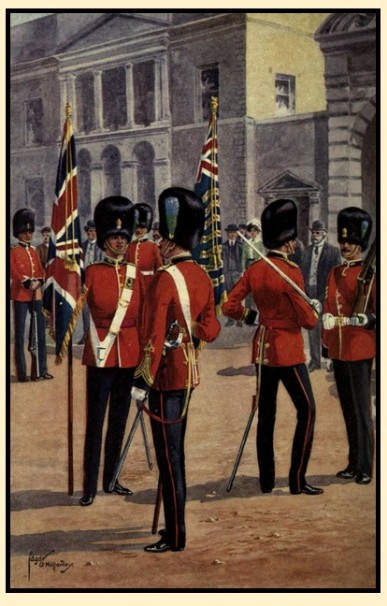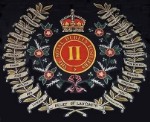The Royal Dublin Fusiliers
The Royal Dublin Fusiliers was created by the War Office in 1881 when it relabeled the 102nd Regiment of Foot (The Royal Madras Fusiliers) and the 103rd Regiment of Foot (The Royal Bombay Fusiliers). The 102nd became the 1st Battalion, Royal Dublin Fusiliers; the 103rd the 2nd Battalion. Both regiments originated in the seventeenth century as all-European formations of the British East India Company. In 1858, with the demise of the BEIC, they became part of the new Indian Army and four years later were transferred by Westminster to the British Army. In 1873, the two regiments were assigned a common recruit depot located in Naas, Co. Kildare.
Three militia regiments were incorporated into the Royal Dublin Fusiliers: The Kildare Rifles (3rd Battalion), The Royal Dublin City Militia (4th Battalion), and The Dublin County Light Infantry (5th Battalion). The recruit depot for all five battalions (two regular, three militia) remained at Naas Barracks. The regiment's primary recruitment territory consisted of Counties Carlow, Dublin, Kildare and Wicklow. The war office designated that area the 102nd Regimental District.
During the Second Boer War, 1899-1902, both of the regiment's regular battalions and two of its three militia battalions served in South Africa. The 2nd Battalion, Major Tweedy's old regiment, incurred heavy casualties in the campaign to relieve Ladysmith.
Pages on Major Tweedy's Neighborhood
Fusiliers' Arch a/k/a Traitors Gate
Located at the northwestern entrance to Dublin's St. Stephen's Green is the Memorial Arch that commemorates the war dead of the Royal Dublin Fusiliers. Built with private funds and completed in 1907, it was promptly dubbed by nationalists "the Traitors' Gate." It is one of the few British monuments in the Republic of Ireland that hasn't been removed officially or destroyed unlawfully.

Unattributed. The Second Battalion Royal Dublin Fusiliers in the South African War, c. 1907.
Download from Major Tweedy's Neighborhood
Documents are in .pdf files. To download a file, click on the document name. The file will open in a new browser window.
Entries for the regiment as of December 31, 1904. Digitized by the National Library of Scotland, 603kb pdf.
Entries for the regiment as of December 31, 1903. Digitized by the National Library of Scotland, 868kb pdf.
Documents on Other Websites
All of these documents are in .pdf files. To download a file, click on the document name or the icon. The file will open in a new browser window. See Download Instructions if you're unfamiliar with the website.
London: Humphreys, 1908. From the Internet Archive, a book by two officers of the battalion. You can download the complete book.
London: Humphreys, 1911. From the Internet Archive, a book by an officer of the battalion. You can download the complete book.
Aldershot: Gale & Polden, 1923. History of the battalion from 1911 through disbandment in 1922. From the Hathi Trust. Partner login credentials required to download the entire book.
Links to Other Websites
Note: The webpages will open in new windows.
Click on the link to go to that page of the website. Click on the icon to go to the website's home page.
This website "promotes the memory of the Irish soldiers who served with the Royal Dublin Fusiliers in the 16th Irish Division in the First World War."
Material on the Royal Dublin Fusiliers, it predecessors, and links to pages for other Irish regiments.
An organization founded in 1996 "to promote a wider awareness of the Irish men and women who served, fought and died in the Great War 1914-18."
A personal website of historical material.


Regimental Nicknames and Traditions of the British Army (London: Gale & Polden, 1916).
Painting by Edgar Holloway.



